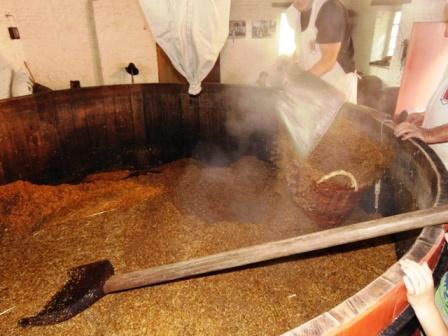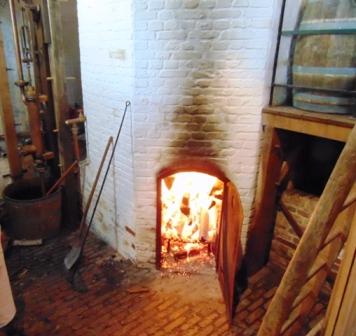For the common people in the Middle Ages beer was a common beverage. It was safer than water that in the cities often was polluted, while beer was cooked and filtered during the preparation. (*)And beer is nutritious: it contains grain and yeast, and is rich in vitamin B.
In the Low Countries, the beers had a sour taste of gueuze. Originally, just the malted and crushed grain was mixed with hot water, the grain moisture was filtered and fermented. Just about every housemother made fresh beer every week, just like bread was baked. Hence the many breweries and cafés everywhere in Flanders.
To improve the shelf life and taste, (bitter) herbs were added later: "Gruyt or Gruut". The composition varied per region. The landlord knew the mixture and levied tax or duty on it.
Amongst others: gale (Myrica gale), marsh rosemary (Ledum palustre), laser herb (Laserpitium siler) and bay berries (Laurus nobilis) may also sometimes be used sage (Salvia officinalis) and yarrow (Achillea millefolium). The accounts of the grit house in Cologne from 1391 and 1393 also mention anise (Pimpinella anisum), juniper berries (Juniperus communis) and caraway (Carvum carvi) to replace the then no longer available laser herb and refined resin. Those choices are the roots of the many different Belgian beers.
Hops was used in Germany from the 13th century as an alternative spice in a (lager) beer preparation. The hop cones were boiled for one hour with the filtered grain moisture (the wort) to release the anticorrosive substances. So a new way of brewing came about with an extra step in the process.
Students of the Wits University in South Africa in 2013 mimicked a 9,000 year old Chinese beer. Centuries ago, a person should have used daily two to three liters of beer, with an alcohol content of less than two percent.
 We first malt barley, this means wetting on a warm, airy floor so that it germinates (12° to 15°C). They grow roots and a ’plume'. Enzymes are formed. Then the barley is dried again (40° to 65°C) and kilned at 80° -85° for lager, and at 115° for dark beer.
We first malt barley, this means wetting on a warm, airy floor so that it germinates (12° to 15°C). They grow roots and a ’plume'. Enzymes are formed. Then the barley is dried again (40° to 65°C) and kilned at 80° -85° for lager, and at 115° for dark beer.
Malt grinding: crush into small pieces (not too fine, no flour!). The husks best remain whole, they serve later as a filter. This works easier if you have the malt slightly moistened. Quickly move to the next step.
Mashing: the seizure of approximately 4 liters of water on 1 kilo malt is kept at increasingly higher temperatures for a certain time to release every time other enzymes.
on 40° stir frequent without bringing air in the mixture
on 50°C for 15 to 30 minutes
62 à 63°C, with a rest period of 10 to 60 minutes.
(You can also work reverse, from high to low temperature.)
 Filter while it’s warm (e.g. via a converted cooler) on a perforated plate at 78°C: the pulp mass acts as a filter. You tap at bottom level the wort with a crane or siphon and pour it back on the top onto the filter cake until the drained wort is clear. Do not allow any, or as little air as possible in the mixture. Keep patiently filtering it again.
Filter while it’s warm (e.g. via a converted cooler) on a perforated plate at 78°C: the pulp mass acts as a filter. You tap at bottom level the wort with a crane or siphon and pour it back on the top onto the filter cake until the drained wort is clear. Do not allow any, or as little air as possible in the mixture. Keep patiently filtering it again.
Then gently rinse the cake with warm water (80 degrees) before he is dry and gets air. Coil sufficiently. More coils gives lighter beer.
The wort is cooked well 1.5 to 2h. Add hops and let it boil for 15 to 60 minutes. Cooking the hop longer makes the beer more bitter.
Allow to settle and cool rapidly among many decantation and aeration.
Add brewer's yeast (wine yeast cannot convert maltose into glucose) starter and let ferment a day or 6. (Lambic Breweries let ferment the mixture spontaneously by wild yeast infection).
Bottling with some sugar to form carbon dioxide and let ripe.
Each phase (and certainly also the quality of the water (about pH 5.6)) affects the character of the beer.
In the early Middle Ages, beer also was flavored with herbs, it was called gruit.
Instead of hops also ivy was used.
Of the hop plant the unfertilized female flowers are used. The cone contains brewing technically spoken components as bitter substances (alpha acids), volatile oils and tannins. It is the bitter substances that give beer its characteristic flavor. These bitter substances also have a preservative effect. By cooking the alpha acids become isomerized, that means more bitter (twice) and more soluble (thirty times).
What is double and triple beer ?
Several explanations for these names came up. They are abbey beers. The ordinary 3 vol % beer for the refectory was made of one deposit (amount of material). With an (almost) doubling of the raw material was 6 % achieved: beer for guests and sales. Any heavier beers were therefore in imitation called triple (9 %). As even heavier beers are already put quad( ruppel, 9 % +) on the label.
Whether the vessels were distinguished in the Middle Ages with one sign for lager, and double crosses for beer for paying guests.
Lower beers are sometimes called single and have an alcohol content of 4.5 - 5.5.
Table beer has an original wort content between 1 and 4 degrees.
Yeasts are more related to animals than to plants, but are neither. They produce scents that attract insects (such as on fruit) that they need as a taxi to move around.
In the sixteenth century, brewers discovered that they could increase the chance of successful and recognizable beer by using sediment from their previous brew as a starter. So they selected wanted yeast variants that can convert specific sugars, are adapted to the circumstances and with the desired flavors. Yeast was actually so domesticated.
(*) Some sources argue that this is a persistent misunderstanding, a premature conclusion inspired by the fact that water as a beverage is rarely mentioned in historical texts. Even today nobody brags about the water that he drank, cf. social media. And it is rarely on a menu! A Byzantine doctor from the 7th century wrote: "water is the most used in every regime" and that "one cannot find a better drink". Cities provided residents with safe water free of charge via village pumps and aqueducts. London built 'The Great Conduit' in 1245 to bring fresh water from a spring at 4.3km to the city. Originally with wooden pipes, later with lead pipes.
Not one man in a beer commercial has a beer belly.( Rita Rudner)
